Understanding Clostridiodes difficile
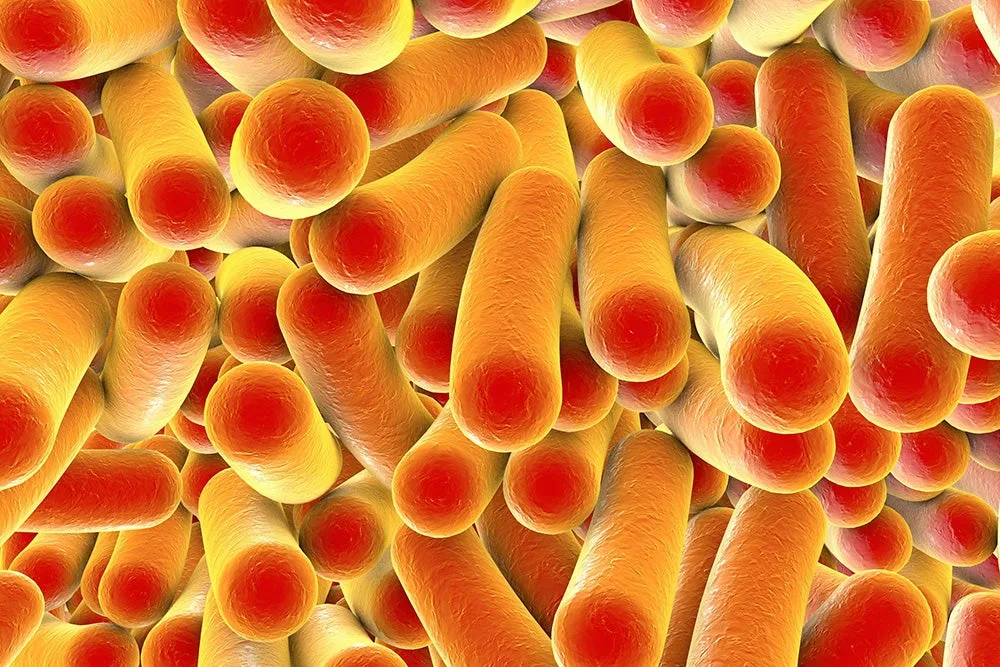
What Is Clostridiodes difficile?
Clostridioides difficile (C. difficile or C. diff) is a spore-forming, toxin-producing bacterium that causes gastrointestinal conditions ranging from diarrhea to colitis.1 C. difficile is estimated to cause half a million infections annually in the United States. These infections commonly occur during or just after taking antibiotics, because antibiotics can kill off the healthy gut flora and provide optimal conditions for C. difficile to overgrow, and can be life-threatening.2 C. difficile can exist in two forms: a dormant spore that has a tough protein coat and persists for long periods of time on surfaces, and a vegetative form that results from spore germination.3 Exposure to C. difficile spores, both in their dormant and vegetative forms, can result in a C. difficile infection (CDI).3 The C. difficile bacterium produces a toxin when germinating in its vegetative form, which is responsible for the symptoms experienced such as gastrointestinal discomfort.
C. difficile Symptoms
C. difficile can cause illness ranging from mild diarrhea to pseudomembranous colitis to toxic megacolon, a rare but life-threatening complication.4 In all cases, the major symptom of CDI is diarrhea. Mild cases may experience only watery diarrhea, while severe cases can include severe abdominal cramping, blood or pus in the stool, nausea, a swollen abdomen, kidney failure and an increased white blood cell count. Some patients require a colectomy — removal of the colon.5 Severe infection can lead to sepsis and death.6
Incubation Period and Duration of Illness
The average incubation period from infection to symptom onset is 3 to 7 days, but symptoms can begin as late as up to 3 months post-exposure. Upon starting antibiotic treatment, most people are able to clear their infection within 1 to 2 weeks. Regardless of treatment, people are still considered infectious and should continue exercising caution until at least 48 hours after symptoms stop.7 People are always at risk of reinfection, especially in the following 2 to 8 weeks post-infection.6
Who Is At Risk?
C. difficile infections can be life-threatening. The risk of contracting a C. difficile infection increases in the elderly and in patients with recent antibiotic use, gastrointestinal surgery, immunocompromising conditions, and long stays in healthcare settings such as hospitals and nursing homes. About 1 in 6 patients who get a C. difficile infection will get it again within 2 to 8 weeks of initial infection.8 The risk of a subsequent infection increases with each new CDI, so it is important to prevent reinfection and use antimicrobial agents.
The Burden of C. difficile
Annually, approximately 500,000 people experience a CDI. Among these cases, about 29,000 deaths result from severe infections.9 C. difficile infections greatly burden the healthcare system and economy as well, costing an estimated $5 billion annually.10 The impact of these infections to the hospital is prolonged length of stay and increased cost. The elderly, who are more immunologically vulnerable and more likely to be in hospitals, are disproportionately affected by C. difficile.
How C. difficile Spreads
Direct and Indirect Contact
C. difficile is shed from feces. Contaminated environmental surfaces and skin can serve as a reservoir for C. difficile spores.3 Transmission through direct contact occurs through the fecal-oral route. Spores can be shed by people with active C. difficile infection, as well as by asymptomatic carriers. Transmission through indirect contact via unclean surfaces and equipment is also possible. Studies on the survival of C. difficile showed that C. difficile spores can persist for months on hard surfaces such as those found in the healthcare environment.11 This long survival period increases the risk of transmission from a contaminated surface that has not been properly cleaned and disinfected.
Preventing the Spread of C. difficile
Hand Hygiene
It is important to practice proper hand hygiene when handling objects in a contaminated room or working with patients infected with C. difficile. Encourage patients to thoroughly wash their hands after using the restroom to prevent any further spread. Wear gloves and gowns when interacting with C. difficile patients and discard these before working with others. Regularly wash your hands with soap and water, scrubbing to create friction to remove the spores from your hands for at least 20 seconds. Practice handwashing whenever exposure to fecal matter or contaminated surfaces is suspected.
Cleaning and Disinfecting Surfaces
Through proper cleaning and disinfection techniques, the spread of C. difficile can be greatly reduced. As a pathogen that can easily survive on surfaces and infect the next patient, it is important to first clean surfaces and then use a sporicidal disinfectant like bleach in contaminated patient spaces. As a gastrointestinal pathogen, it is very important to thoroughly disinfect bathrooms used by CDI patients. Wear personal protective equipment (PPE) while cleaning and disinfecting.12 After cleaning to remove all debris and organic matter from surfaces, use an EPA-registered sporicidal disinfectant that has been approved for killing C. difficile spores on surfaces. Ensure that cleaning and disinfection occurs twice daily in healthcare settings with all high-touch surfaces, especially in CDI patient isolation rooms.
Overal Recommendations for CDI Prevention in Healthcare
The CDC recommends the following steps for CDI prevention in healthcare:3
- Antibiotic stewardship: A program that promotes the appropriate use of antimicrobials.
- Hand hygiene: Practice hand hygiene using soap and water; alcohol-based hand sanitizers do not inactivate C. difficile.
- Isolation: Rapidly identify and isolate patients with CDI in a private room. Dedicate equipment, as able, to the infected patient’s room.
- Diagnostic stewardship: Appropriate testing (e.g., test when indicated such as unexplained diarrhea).
- Personal Protective Equipment (PPE): Wear gloves and gowns when caring for C. difficile patients.
- Cleaning & disinfection: Clean CDI patient rooms daily and on discharge with an EPA-registered disinfectant with claims against C. difficile spores
- Interfacility communication: When a C. difficile patient transfers between facilities along the continuum of care, notify the receiving facility of the infection.
CloroxPro Products Effective Against C. difficile
It is important to clean surfaces potentially contaminated with C. difficile before disinfecting. The CDC recommends use of a sporicidal disinfectant that is registered with the Environmental Protection Agency (EPA) and is effective against C. difficile (see EPA List K).13 Follow the directions for use, including applying the product for the correct contact time. Specifically, the CDC recommends:
- Disinfect occupied isolation rooms and restrooms twice daily with a C. difficile sporicidal disinfectant such as bleach, with special attention to high-touch surfaces.
- For terminal cleaning, use a C. difficile sporicidal disinfectant after CDI patient transfer or discharge. Consider using an adjunct disinfecting technology upon completion of manual cleaning and disinfection.
- Disinfect areas potentially contaminated during transient visits by patients with suspected or confirmed CDI, including waiting rooms.
- Medical equipment should be disinfected after each patient.
The following Clorox Healthcare cleaner disinfectants can be used to effectively manage C. difficile on environmental surfaces and equipment in healthcare settings:
| Product | Contact Time | Product Image |
|---|---|---|
| Germicidal Wipes EPA Reg. No. 67619-12 5″ x 6″ Clinical Wipes, 6/150 ct., Item No. 30577 6.75″ x 9″ Multi-purpose Wipes, 6/70 ct., Item No. 35309 6.75″ x 9″ Multi-purpose Wipes, 6/100 ct., Item No. 32621 12″ x 12″ Terminal Wipes, 2/110 ct., Item No. 30358 12″ x 12″ Terminal Wipes Refill, 2/110 ct., Item No. 30359 | 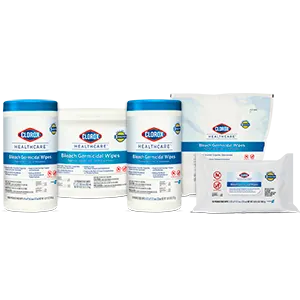 | |
| Germicidal Cleaners EPA Reg. No. 56392-7 6/32 fl. oz. Spray, Item No. 68970 6/32 fl. oz. Pull-Top, Item No. 68832 4/128 fl. oz. Refill, Item No. 68978 | 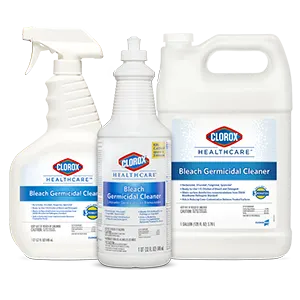 | |
| Fuzion EPA Reg. No. 67619-30 9/32 fl. oz. Spray, Item No. 31478 | 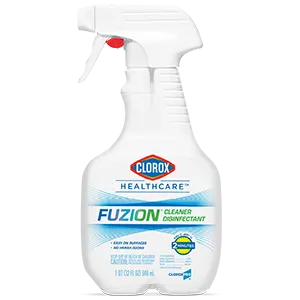 | |
| Clorox Healthcare Spore Defense Cleaner Disinfectant EPA Reg. No. 67619-40 4/128 fl. oz., Item No. 32122 4/128 fl. oz., Item No. 32409 | 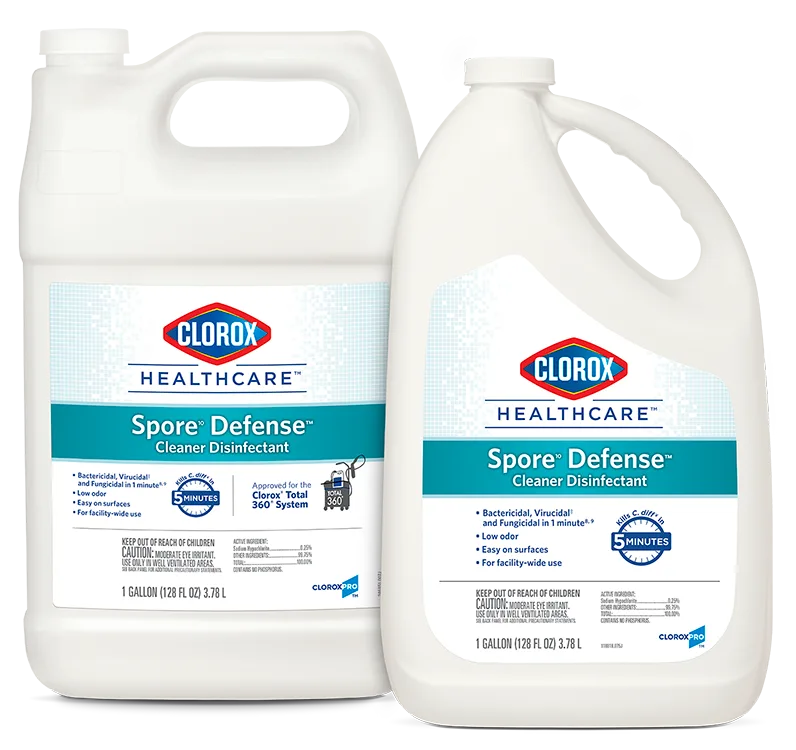 | |
| Hospital Cleaner Disinfectant Towels with Bleach EPA Reg. No. 56392-8 6.75″ x 9″ Multi-purpose Wipes, 6/70 ct., Item No. 35309 | 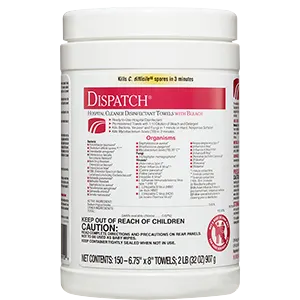 |
Other Resources
Educational Resources
- C. diff Pathogen Education Sheet
- C. diff Environmental Services Terminal Cleaning Protocol & Checklist
- Bleach Facts: Your Defense Against the Toughest HAI-Causing Pathogens
- Three-Part Series: Cleaning & Disinfection — From Basics to Innovation
- Infection Prevention in Long-Term Care: Focus on the Environment
Clinical Evidence
- Bleach-Based Disinfectants in Healthcare Settings – Summary of Clinical Evidence
- Impact of Routine Use of a Spray Formulation of Bleach on C. difficile
Blog Posts
References
1. Mayo Clinic. C. difficile infection https://www.mayoclinic.org/diseases-conditions/c-difficile/symptoms-causes/syc-20351691 (Accessed August 1, 2025).
2. Centers for Disease Control and Prevention (CDC). C. diff (Clostridioides difficile) https://www.cdc.gov/cdiff/index.html (Accessed August 1, 2025).
3. Centers for Disease Control and Prevention (CDC). FAQs for Clinicians about C. diff https://www.cdc.gov/c-diff/hcp/clinical-overview/index.html (Accessed August 1, 2025).
4. Johns Hopkins Medicine. Toxic Megacolon https://www.hopkinsmedicine.org/health/conditions-and-diseases/toxic-megacolon (Accessed August 1, 2025).
5. Surgical management of Clostridioides (formerly Clostridium) difficile colitis in adults https://www.uptodate.com/contents/surgical-management-of-clostridioides-formerly-clostridium-difficile-colitis-in-adults (Accessed August 1, 2025).
6. Centers for Disease Control and Prevention. What is C. diff? https://www.cdc.gov/cdiff/what-is.html (Accessed August 1, 2025).
7.NHS. (2023). Clostridium difficile. NHS Inform. https://www.nhsinform.scot/illnesses-and-conditions/infections-and-poisoning/clostridium-difficile/ (Accessed August 1, 2025).
8. Guh, A. Y.; Mu, Y.; Winston, L. G.; Johnston, H.; Olson, D.; Farley, M. M.; Wilson, L. E.; Holzbauer, S. M.; Phipps, E. C.; Dumyati, G. K.; Beldavs, Z. G.; Kainer, M. A.; Karlsson, M.; Gerding, D. N.; McDonald, L. C. Trends in U.S. Burden of Clostridioides Difficile Infection and Outcomes . N. Engl. J. Med. 2020, 382 (14), 1320–1330. https://doi.org/10.1056/NEJMOA1910215/SUPPL_FILE/NEJMOA1910215_DISCLOSURES.PDF.
9. CDC. (2025, June 24). Clostridioides difficile Infection (CDI) Surveillance. Healthcare-Associated Infections (HAIs). https://www.cdc.gov/healthcare-associated-infections/php/haic-eip/cdiff.html (Accessed August 1, 2025).
10. Malone, D. C., Armstrong, E. P., Gratie, D., Pham, S. V., & Amin, A. (2023). A systematic review of real-world healthcare resource use and costs of Clostridioides difficile infections. Antimicrobial Stewardship & Healthcare Epidemiology, 3(1). https://doi.org/10.1017/ash.2022.369
11. Kramer, A.; Schwebke, I.; Kampf, G. How Long Do Nosocomial Pathogens Persist on Inanimate Surfaces? A Systematic Review. BMC Infect. Dis. 2006, 6. https://doi.org/10.1186/1471-2334-6-130.
12. CDC. (2024, April 23). Preventing C. diff. C. Diff (Clostridioides Difficile). https://www.cdc.gov/c-diff/prevention/index.html (Accessed August 1, 2025).
13. Environmental Protection Agency. List K: EPA’s Registered Antimicrobial Products Effective against Clostridium difficile Spores https://www.epa.gov/pesticide-registration/list-k-epas-registered-antimicrobial-products-effective-against-clostridium (Accessed August 1, 2025)













